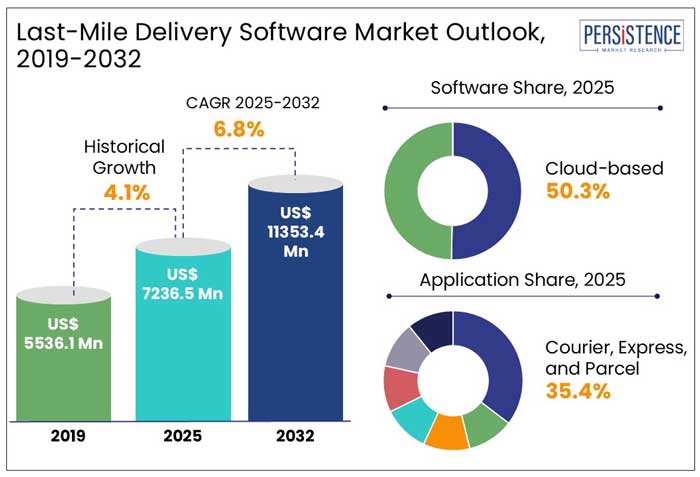Industry: IT and Telecommunication
Published Date: February-2025
Format: PPT*, PDF, EXCEL
Delivery Timelines: Contact Sales
Number of Pages: 184
Report ID: PMRREP33641
The global last-mile delivery software market size is anticipated to reach a value of US$ 7,236.5 Mn in 2025 and is set to witness a CAGR of 6.8% from 2025 to 2032. The market will likely attain a value of US$ 11,353.4 Mn in 2032.
Picture this- a package that you ordered in the morning arrives at your doorstep by the evening. Though it seems easy, a convoluted logistical struggle takes on behind the scenes. At 53% of total shipping expenses, the last-mile delivery segment, which is in charge of transporting items from distribution centers to consumers, is the most costly and time-consuming aspect of the supply chain.
Businesses are under constant pressure to fulfill the increasing demand for quick deliveries. Traditional delivery methods, however, were often associated with high fuel expenses, missing deliveries, and inefficiencies. Use of AI, real-time tracking, and route optimization by last-mile delivery software can drastically reduce delivery times, save expenses, and improve customer satisfaction.

Key Highlights of the Last-mile Delivery Software Industry
|
Global Market Attributes |
Key Insights |
|
Last-mile Delivery Software Market Size (2025E) |
US$ 7,236.5 Mn |
|
Market Value Forecast (2032F) |
US$ 11,353.4 Mn |
|
Projected Growth (CAGR 2025 to 2032) |
6.8% |
|
Historical Market Growth (CAGR 2019 to 2024) |
4.1% |
E-commerce Boom during COVID-19 Pushed Online Sales, Transforming Consumer Shopping Habits
In the historical period from 2019 to 2024, the global last-mile delivery software industry witnessed a CAGR of 4.1%. From 2019 to 2022, e-commerce showcased tremendous growth due to the coronavirus outbreak.
Online sales in the U.S. more than doubled their 2019 figures in 2020, with a 32.4% year-over-year growth rate. Analysts predict that online shopping will continue to rise, but not at the same astounding rate, even when COVID-19 is under control.
The convenience of shopping from home became second nature to people: three out of four Americans wanted their online orders delivered straight to their doorstep. This put more strain on logistics, particularly on last-mile delivery, which was its final stage.
Increasing online shopping activities further led to significant transformations in the market as companies focused on launching efficient delivery solutions. Mergers and acquisitions were also an important strategy that companies adopted.
New Software Solutions Capable of Measuring Emissions to Create Avenues through 2032
From 2025 to 2032, the last-mile delivery software industry is likely to showcase a CAGR of 6.8%. Sustainability is having a big impact on logistics in 2025, especially last-mile deliveries. In logistics, sustainability refers to the practical measures companies take to reduce the environmental effect of their operations, such as carbon offsetting, reducing emissions through transport route optimization, and converting to electric vehicles.
Businesses are paying more attention to green logistics practices. It is because of the European Environment Agency's prediction that, in the absence of effective measures, logistics might be responsible for up to 40% of global carbon dioxide emissions by 2050. By effectively planning delivery routes and lowering the distance that delivery vehicles must drive while using less fuel, route optimization software like Circuit is currently being used to cut carbon emissions in last-mile deliveries.
Growth Drivers
Integration of Delivery Software Solutions to Simplify Logistics and Meet Consumer Expectations
Rising integration of delivery software solutions with existing systems is anticipated to propel the last-mile delivery software market growth by 2032. The partnership between IBM Sterling Order Management and Walmart GoLocal in January 2025 is an ideal example of this driver.
IBM's retail clients may now easily integrate Walmart GoLocal's extensive last-mile delivery solutions into their operations due to this partnership. Retailers can improve their order fulfillment procedures and give customers quicker, more effective delivery by utilizing Walmart GoLocal's capabilities.
Use of last-mile delivery software is set to be bolstered by such integrations. These are not only projected to simplify logistics but also offer companies the ability to satisfy the rising demand from customers for dependable and speedy shipping choices.
Compliance with Strict Regulations Poses Challenges for Last-mile Delivery Software Vendors
Regulatory and pre-existing infrastructure issues severely limit the market for last-mile delivery software. One significant obstacle that prevents the seamless deployment of efficient last-mile deliveries is the presence of inadequate or crowded urban infrastructure. Additionally, the implementation of strict rules in several areas creates challenges for last-mile delivery software vendors to guarantee compliance and adaptability. For example,
Such norms are projected to highlight the significant challenges that vendors face in meeting compliance requirements while maintaining a smooth process in their services.
Companies Focus on Launching Route Planning and Optimization Software to Enhance Delivery Processes
Key companies in the global market are likely to gain opportunities with the launch of route planning and optimization software solutions. These are set to enable organizations to expedite delivery procedures, make deliveries on time, and increase productivity. As these cut down on delivery times, these are considered an essential solution for businesses that depend on frequent deliveries. By lowering consumption of gasoline and reducing the number of vehicles required for delivery, these solutions also help lower total expenses.
Retail companies receiving a high volume of online orders are set to be the target audience for such software solutions. They are anticipated to utilize route planning and optimization-based last mile delivery platforms to complete all deliveries. These are also projected to help adapt to external factors, such as weather conditions and traffic.
Software Insights
Cloud-based Last-mile Delivery Software Gains Traction with Flexibility and Scalability
By software, the cloud-based segment is anticipated to hold a last-mile delivery software market share of 50.3% in 2025. High flexibility, scalability, and cost-effectiveness offered by cloud-based software solutions is set to empower companies to rapidly adjust to changing consumer requirements.
As software-as-a-service (SaaS) models are becoming immensely popular, the cloud-based segment is rising at a fast pace. By facilitating easy upgrades, more accessibility, and integration with innovative technologies, this trend encourages developments in last-mile logistics. Conversely, the on-premises segment remains significant for businesses with unique security and control requirements, even with its relatively slow growth.
Application Insights
Real-time Tracking and Communication Features to Enhance Courier, Express, and Parcel Delivery Services
In terms of application, the courier, express, and parcel segment will likely hold a share of 35.4% in 2025. Last-mile delivery software solutions are capable of providing end-to-end visibility to customers regarding the status of their orders in the courier, express, and parcel segment. Right from placing an order, shipping information to when the customer will receive the order, everything is provided by these solutions.
This feature helps in boosting transparency among both customers and courier service providers, which positively impacts a customer’s trust in the company. Customers can also chat with delivery executives to better coordinate product deliveries.
The e-commerce segment will likely witness a steady growth rate through 2032. Ability of last-mile delivery software to enhance customer providing accurate delivery estimates and optimizing delivery routes is anticipated to create high demand in the e-commerce sector. Advanced analytics offered by the software can also help detect areas for improvement and inform strategic decision-making.
North America Last-mile Delivery Software Market
North America's Last-mile Delivery Software Industry to Surge with Robotics and Retail Collaborations
North America will likely account for a share of 32.8% in 2025. With the B2C category leading in revenue generation, this growth is mainly attributed to rising demand for effective delivery options.
Autonomous delivery vehicles and other innovations are becoming increasingly common. For instance, in the U.S., Uber has started using Avride's autonomous robots to carry food in locations like Jersey City. Such innovations are anticipated to require cutting-edge software for smooth operations.
In Canada, companies like DoorDash are extending their services beyond food delivery. They are joining hands with retailers, such as Ulta Beauty and Lowe's to provide comprehensive last-mile solutions, further increasing competition with conventional logistics providers like FedEx and UPS. Evolving customer expectations and innovations in software are set to create opportunities in North America.
Europe Last-mile Delivery Software Market
Consumer Expectations for Delivery Speed Prompting Investments in Last-mile Delivery Software in Europe
Europe-based businesses are making significant investments in technology to improve the effectiveness of last-mile delivery software. For example,
Significant progress is also being made by start-ups. Kanguro, a logistics start-up based in Barcelona, has raised €2 Mn to assist its expansion across Europe and the development of its AI-powered last-mile delivery optimization solution.
Kanguro boosted its revenue in Spain by 200% in just three months, and in early 2025, it intends to enter Portugal, France, and Germany. With 5,000 operational convenience stores across Spain, the company has effectively surpassed the industry average of 3% by converting 45% of house deliveries to out-of-home deliveries.
Asia Pacific Last-mile Delivery Software Market
Drone Deliveries and Quick Commerce to Transform Last-mile Software across Asia Pacific
Asia Pacific is undergoing significant transition, attributed to unique regional dynamics. Boom of quick commerce across developing countries like India is estimated to create opportunities for last mile routing software providers. The quick commerce market in India grew from US$ 100 Mn in 2020 to a projected US$ 6 Bn in 2024, demonstrating the country's rapid progress.
Start-ups like Zomato, Swiggy, and Zepto are mainly responsible for this growth as they have made fast deliveries, often within 10 to 30 minutes, common. Conglomerates in India like Reliance are responding to this trend by reorganizing their retail businesses and incorporating quick commerce services into their current infrastructure of supermarkets.
Drone delivery services are being pioneered by China’s enterprises to improve last-mile logistics. For example,
By offering same-day delivery in Sydney, Amazon has greatly improved its logistics skills in Australia. This move is a component of a larger US$ 1.6 Bn investment that aims to extend Prime one-day delivery to cities like Brisbane and develop additional fulfillment centers as part of Amazon's local network expansion. These initiatives highlight the rising demand in the country from customers for quick delivery services. With the aforementioned developments, Asia Pacific is set to witness an influx of route optimization software to improve delivery speed and efficiency.
Key companies in the global last-mile delivery software market are striving to broaden their portfolios and strengthen their position through new product launches, collaborations, and partnerships. Mergers and acquisitions are also anticipated to play a significant role in boosting a company’s presence. For example,
A few other companies are focusing on investing huge sums in research and development activities to come up with novel software solutions that help address the changing needs of organizations. For example, the predictive analytics platform from Bringg, a cloud-based last mile delivery tracking software provider, was recently launched. It uses machine learning algorithms to increase customer happiness and delivery efficiency.
Key Industry Developments
|
Report Attributes |
Details |
|
Historical Data/Actuals |
2019 - 2024 |
|
Forecast Period |
2025 - 2032 |
|
Market Analysis Units |
Value: US$ Bn/Mn, Volume: As applicable |
|
Geographical Coverage |
|
|
Segmental Coverage |
|
|
Competitive Analysis |
|
|
Report Highlights |
|
|
Customization and Pricing |
Available upon request |
By Software
By Application
By Region
To know more about delivery timeline for this report Contact Sales

The market is set to reach a value of US$ 7,236.5 Mn in 2025.
Electric vehicles, robots, and drones are a few technologies.
It is significant in e-commerce as it directly affects customer experience, brand reputation, and loyalty.
The industry is anticipated to reach US$ 11,353.4 Mn in 2032.
Oracle Corporation, Locus Robotics Corp., and Amazon.com, Inc. are a few providers.